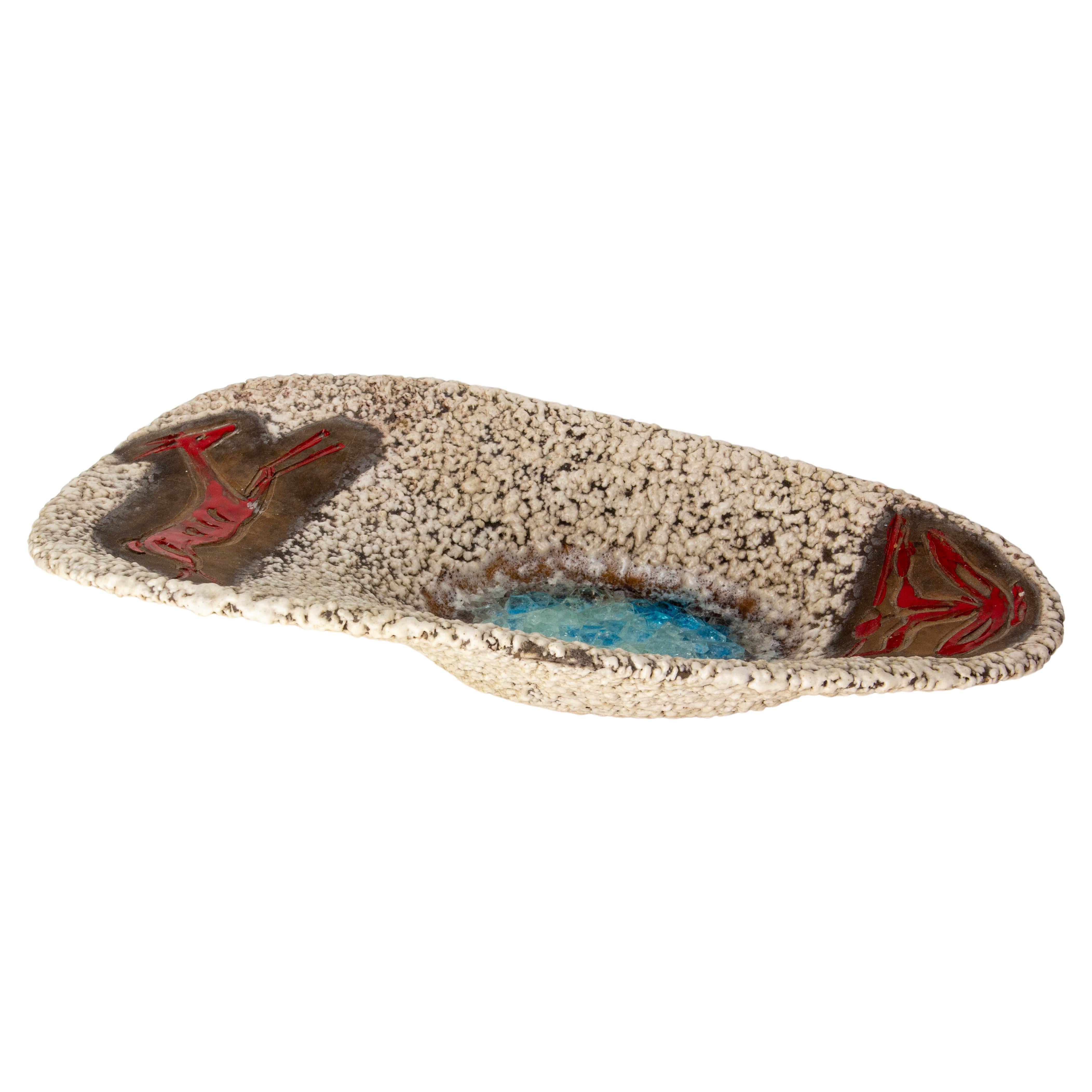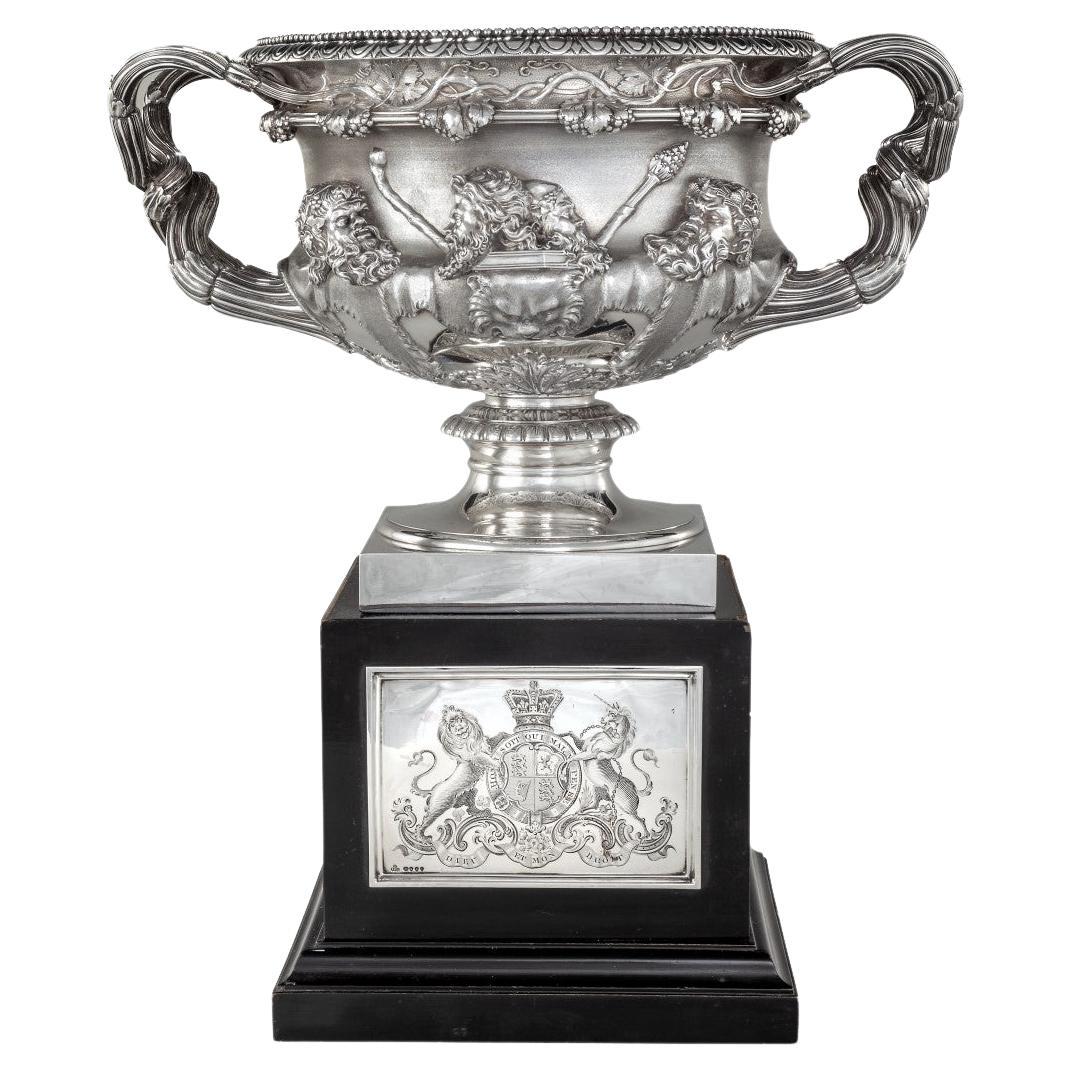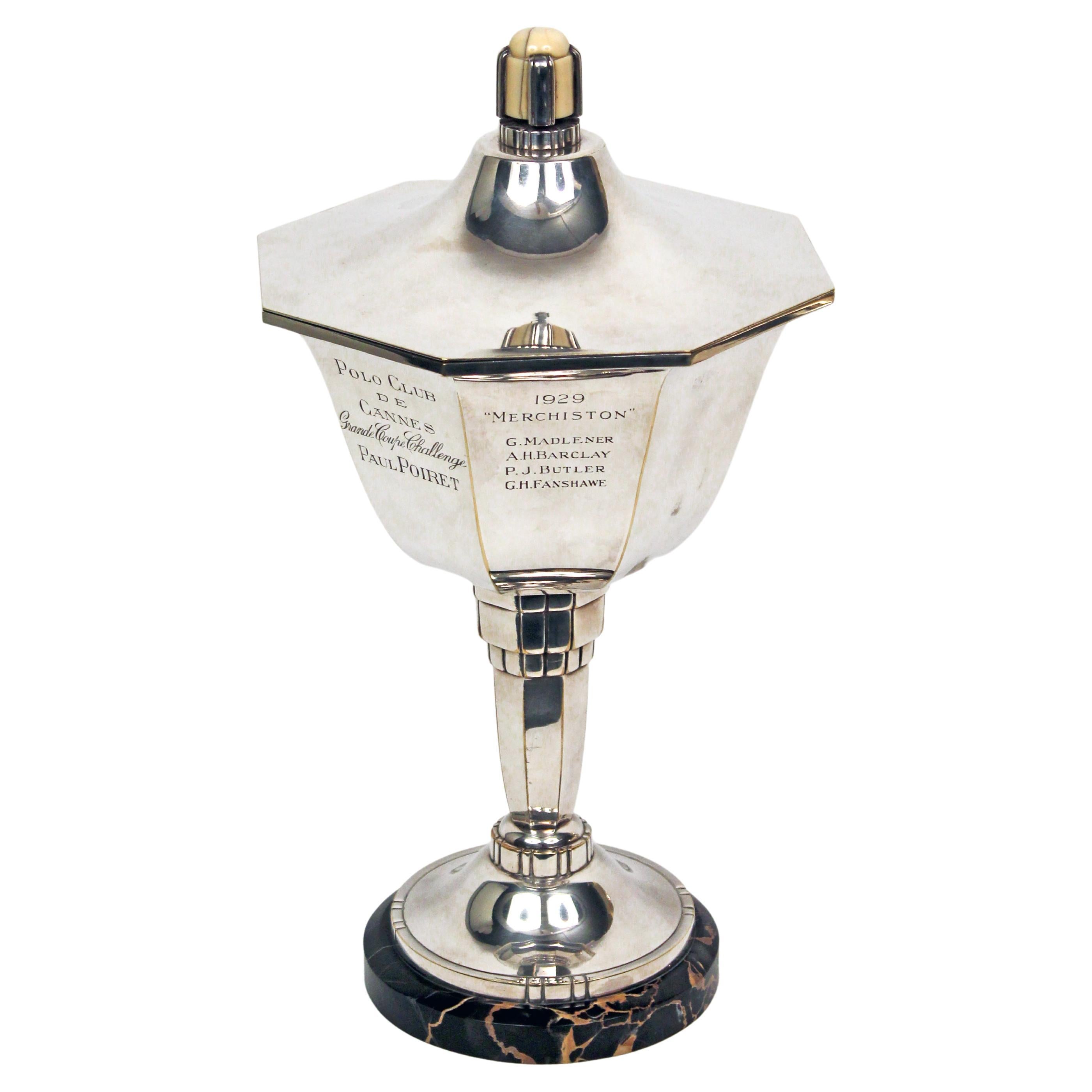Items Similar to French Deer Hunting Trophy by Jean-Francois Deniere Circa 1836
Want more images or videos?
Request additional images or videos from the seller
1 of 19
French Deer Hunting Trophy by Jean-Francois Deniere Circa 1836
About the Item
Our amazing silver-gilt and gilt-metal hunting cup with its original presentation case was designed by Jean-Francois Deniere for Baron Johan-George Schickler to celebrate his downing of a ten-point stag near Paris in November of eighteen thirty-five.
It has an oval gadrooned base cast with gothic style foliage and applied in the front with a rococo cartouche and coat-of-arms and two shields with initials GS for Baron Johan-Georg Schickler. The stem is formed as a stag's hoof topped by an oak leaf crown above a band of gothic scrolls framing cartouches engraved with inscription, the base fitted with a silver plaque engraved with inscription, with detachable cut-glass cup and original fitted leather case, engraved on base DENIERE A PARIS.
The inscription around the crown reads HALLALI, CARYAN, Porté bas près de Sèvres and attaqué le 6 Novembre 1835 près de Bonnelles. This translates to: KILL, CARYAN carried low near Sèvres and attacked on November 6, 1835 near Bonnelles. The prey celebrated by this trophy apparently named Caryan with the word Hallali translated to the noun, kill.
The inscription on the silvered plaque translates to: This passage translates to: Deer hoof, ten horns, caught by Aubry dit La Branche, first Piqueur of the Mons crew. Baron SCHICKLER, November 6, 1835 at a quarter past twelve in the Bois du Chaillot, near Bonnelles, attacked by 32 dogs and door low, from pack to death without relay at 5 a.m. at Chavilles, near Sèvres, in the yard of a launderer by 20 of the attack dogs, whose names follow. Blucker, Belford, Barbareau, Claireau, Charboneau, Concordan, Flambeau, Fortuneau, Phanor, Forester, Fleuribeau, Gravador, Matador, Mirador, Munireau, Musicau, Marmiteau, Ramponeau, Rafineau, Thibeau. The stag crossed the Parc de Limours, Forges, Janvrys, the woods of Charmeaux, the pond of Marcoussy, Orsay, Palaiseau, the woods of Verrières and those of Meudon and he made five outlets.
Johan Georg Schickler was born in Bordeaux in a wealthy Prussian banking family who emigrated to Switzerland in the 16th century, first in Basel before moving to Mulhouse, Berlin and finally Paris. The family moved in the highest Parisian social circles acquiring the famous hôtel Crozat on the Place Vendôme in 1828 which they filled with works of arts and painting especially equestrian by Carle and Horace Vernet, Géricault, and Eugène Delacroix as the family had a passion for horse racing and hunting. Denière was a bronze maker retailing furnishings, chandeliers, clocks, candelabra, torchères and ornamental mantel clocks, established in 1804 by Jean-Francois Deninger (called Denière) and François Thomas Matelin.
Jean-François Dénière established his business as a fabricant de bronzes in 1803. He was at 58 rue de Turenne in 1813 and by 1820 at 9 rue d'Orléans au Marais. He went into partnership with his son Guillaume in 1844. According to the notes on makers in the French version of the catalogue for the 1862 International Exhibition in London, they were one of the first serious competitors to Thomire. The company's work was illustrated by J.B. Waring in his treatises on both the 1851 and the 1862 exhibitions, and George Wallis of the South Kensington Museum wrote in his analysis of the bronzes and works of art for the Art Journal Supplement 1851 that decorative adjuncts in bronze ormolu formed a very striking feature of Deniere's display. The firm exhibited widely to the end of the century and finally closed in 1903 some sixty years after Thomire. Denière supplied the French and European courts such as Versailles, the Grand Trianon, Buckingham Palace, the Hermitage and the White House. Princes and kings figured among Denierè’s wealthy clients and Denière supplied important commissions to the Mobilier de la Couronne (mainly clocks for the Tuilleries), to Kisselef, the Russian Ambassador, and to Said Pasha, the viceroy of Egypt.
- Dimensions:Height: 11 in (27.94 cm)Width: 8.5 in (21.59 cm)Depth: 3.5 in (8.89 cm)
- Style:Louis Philippe (Of the Period)
- Materials and Techniques:
- Place of Origin:
- Period:
- Date of Manufacture:1836
- Condition:Wear consistent with age and use. Mounting screws for silver plaque missing.
- Seller Location:New York, US
- Reference Number:
About the Seller
No Reviews Yet
Vetted Seller
These experienced sellers undergo a comprehensive evaluation by our team of in-house experts.
Established in 1990
1stDibs seller since 2021
Typical response time: 1 to 2 days
- ShippingRetrieving quote...Ships From: New York, US
- Return PolicyA return for this item may be initiated within 2 days of delivery.
More From This SellerView All
- Continental Grand Tour Marble TazzaLocated in New York, USOur large neoclassical tazza carved from variegated charcoal colored marble with red and grey dates from the nineteenth century. Provenance: Jay Waldmann, Waldmann Inc., Southampt...Category
Antique Late 18th Century European Grand Tour Centerpieces
MaterialsMarble
- Jean Bonnardel Portrait by Federico MassesLocated in New York, USOur very large portrait of Jean Bonnardel (1899-1952), Countess Madeleine de Montgomery, by Federico Armando Beltran Masses (1885-1949) measures 77 3/8 ...Category
Vintage 1930s French Art Deco Paintings
MaterialsCanvas
- Francois-Raoul Larche Bronze Sculpture La Tempête et les NuéesLocated in New York, USOur important bronze by Francois-Raoul Larche (1860-1912), cast circa 1905, is entitled La Tempête et les Nuées (The Storm and the Clouds). Signed RAOUL. LARCHE and stamped with the ...Category
Early 20th Century French Neoclassical Revival Figurative Sculptures
MaterialsBronze
- La Femme Au Voile by Jean Leon Gerome (1824-1904)By Jean-Léon GérômeLocated in New York, USOur bronze statue of La Femme au Voile (Woman with Veil) was cast by Siot Decauville of Paris after the original model by Jean Leon Gerome (1824-1904). 33 3/4 inches (85.7 cm) tall ...Category
Antique Late 19th Century French Figurative Sculptures
MaterialsBronze
- Historic King Louis Philippe Ormolu Bronze Mantel Clock, Circa 1838Located in New York, USOur French ormolu bronze mantel clock, circa 1838, is entitled "Le Roi Louis Philippe saigne sa propre main & rappelle à la vie le courrier de cabinet Werner tombé de cheval sous les...Category
Antique Mid-19th Century French Louis Philippe Mantel Clocks
MaterialsBronze
- Napoleonic Silverplated Tray by Christofle circa 1850By ChristofleLocated in New York, USOur Christofle silverplated tray features fine engraved designs including the French coat-of-arms, and Napoleonic cipher and imperial bees. Reverse has the maker's mark in oval carto...Category
Antique Mid-19th Century French Empire Sheffield and Silverplate
MaterialsSilver Plate
You May Also Like
- Centerpiece "The Naiad", attributed to G. Denière, France, circa 1870By Guillaume DenièreLocated in PARIS, FRExceptional centerpiece in silvered and gilded bronze, composed of a naiad riding a dolphin, supporting a chiseled shell decorated with reeds, adorned with the head of a river god on its bow and on which a winged love blows in a conch. The whole rests on a pedestal decorated with dolphin heads and cut-out leathers, ending with a porphyry base with molded steps. Historical and artistic context Centers and naves of tables are attested in France from the Middle Ages in order to present spices and other condiments brought from distant lands around the Mediterranean or from the trade of the Silk Roads. The importance of their presence on prestigious tables will be confirmed throughout the decorative arts, evolving during the 19th century in centerpieces, becoming a central element of decoration. Here we find a true virtuosity in the composition and representation of the human figure which is reminiscent of the greatest artists of the Italian Renaissance. Indeed, the fluidity of the lines of the naiad can be compared to the nymph of Fontainebleau by Benvenuto Cellini preserved at the Louvre museum and dated 1545, while the naturalist representation of the marine setting refers to the work of Wenzel Jamnitzer...Category
Antique 1870s French Renaissance Revival Centerpieces
MaterialsMarble, Bronze
- French Dish Rock-Inspired Illustration Centerpiece Hunter Deer & Lake, c. 1960Located in Labrit, LandesFrench dish of the 1960s The illustration of this dish depicts a hunting scene with the hunter and his prey: a deer. They are separated by a lake. The lake...Category
Vintage 1960s French Mid-Century Modern Decorative Bowls
MaterialsCeramic
- Her Majesty’s Vase: A horse racing trophy by John Samuel HuntBy John Samuel HuntLocated in Lymington, HampshireThis silver presentation vase is a small replica of the classical Roman ‘Warwick Vase’. The body is cast and chased with fruiting vines below the rim. The central field has a continuous band with bearded Bacchic heads floating above a lion’s mask and pelt. The applied handles comprise gnarled twisted vine stems. The spreading stem is set on a square foot which in turn sits on an ebonised wooden plinth base. The plinth is applied with two vacant laurel wreath cartouches and two rectangular plaques, one finely engraved with the Royal Coat of Arms and the other inscribed “Plymouth, Devonport and Cornwall Races 1845, the gift of her Most Gracious Majesty Queen Victoria, Augustus Coryton Esqr, W. R. Fortescue Esqr, Stewards” and “Her Majesty’s Vase, value 100gs., for three-year-old and upwards – Heats, about two miles, starting at the T.Y.C. Starting-post, once round, to the Grand Stand Winning-post.” Fully marked and stamped on the side of the foot ‘Hunt & Roskell Late Storr & Mortimer 2225’. English, assayed for London 1845. Provenance: Her Majesty Queen Victoria. Sir John Barker-Mill, Baronet of Mottisfont.Thence by descent. John Barker (1803-1860) was created 1st Baronet ‘of Mottisfont in the County of Southampton’ on 16 March 1836. A noted racehorse owner, Barker won numerous prestigious trophies with Giantess, Cymba, Miss Ellis and Pugilist. His most prestigious horse, Leviathan, sire of Giantess, won 16 of 21 starts and was sold to George IV for 2,000 guineas. Plymouth, Devonport and Cornwall Races were held from 1828 until 1930. The racecourse was a flat, oval course of 12 furlongs with a straight run-in of 2 ½ furlongs. ‘Royal Plates...Category
Antique 1840s English Historical Memorabilia
MaterialsSilver
- Art Deco Silver Plated Trophy by Paul Poiret, Dated 1929By Paul PoiretLocated in Miami, FLArt Deco silver plated trophy dated 1929 designed by Paul Poiret, made of silver plated metal a details and marble. Made in France Dated: 1929.Category
20th Century French Art Deco Centerpieces
MaterialsSilver Plate
- French 19th Century Belle Époque Period Centerpiece Attributed To François LinkeBy François LinkeLocated in West Palm Beach, FLA stunning and extremely high quality French 19th century Louis XVI st. Belle Époque period Rouge Griotte marble and ormolu centerpiece attributed to François Linke. The centerpiece ...Category
Antique 19th Century French Louis XVI Centerpieces
MaterialsMarble, Ormolu
- Antique English Cut Crystal and Sheffield Silver Epergne with Deer, Circa 1900'sLocated in New Orleans, LAStunning Antique English Cut Crystal and Sheffield Silver Epergne with Deer, Circa 1900's.Category
Early 20th Century English Centerpieces
MaterialsCrystal, Sheffield Plate
Recently Viewed
View AllMore Ways To Browse
Silver Past
International Silver Company
The International Silver Company
Carries Jean
Jean Carries
Oak Glass Front
Silver Crown French
Silver Frame Art Work
French Rococo Silver
Museum Glass Display
Antique Glass Horses
Hunting Glass
Silver Trophy
Silver Trophies
Silvered Trophy
Dogs Hunting
Antique Silver Horse
Silver Hunting





